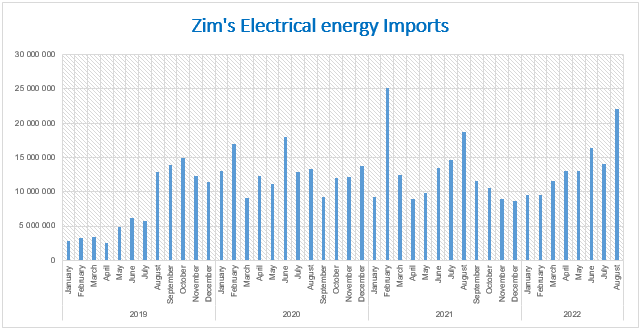
eBusiness Weekly

Rufaro Hozheri
If you just walk to any economic agent who cares to listen to you and ask about Zimbabwean products, you are most likely hear a lot of complaints about how Zimbabweans imports almost everything.
The argument goes on to say that we should be at least manufacturing the basics locally and thereby creating jobs, since each time you import a good you are indirectly exporting jobs. Whether the argument holds water or not, depends on the school of thought you subscribe to.
However, we can all agree that these concerns have been raised and some steps were taken to try to correct them. You will remember S.I 64 of 2016 which was aimed at protecting the local industry by introducing import licences and restricting the importation of some basic goods. Initiatives like the Buy Zimbabwe campaign also followed all in an attempt to encourage production and consumption of local goods and services.
It would be interesting to however break down Zimbabwe’s Import Data to analyse what exactly we spend our money on, in the international market. The data used in this article stretches from January 2017 to August 2022, so it is likely that some goods that Zimbabweans used to consume a lot during the dollarisation era might not appear.
- Electrical Energy
This one was a bit of a surprise to me, I acknowledge that we import electrical energy but not to that extent considering our own power generation is Hwange and Kariba. During that period we imported just under US$510 million, with the highest import consumption in the year 2020 when the country was under a strict lockdown. It is also key to note that during that time households started to rely on solar as an alternative source of energy. With lower levels of water in the Kariba Dam and the aging Hwange station, we need to increase our power generation locally if we do not wish to continue importing electrical energy.
- Maize and Maize Meal
As our staple diet, it is no surprise that Zimbabweans consume significant amount of maize and maize meal. Perhaps the only surprise to someone who doesn’t follow these trade numbers is that we import so much. At one point we used to have more grain than we needed, but due to various factors we now find ourselves at the other side of the trade.
A total of US$541 million was spent on the importation of maize during that time. It is also important to remember that Zimbabwe experienced a number of droughts including Cyclone Idai-induced drought during that time.
In my opinion Zimbabwe seem like it takes agriculture seriously. If you check the balance sheet of the biggest banks, you’ll notice that they lend significantly towards this sector. However, the results are showing that either we need to do more or to change how we approach agriculture.
- Fertilisers
Just to cement the point above, we spent over US$850 million towards ammonium nitrate, phosphate, organic and inorganic fertilisers during that time.
Fertiliser is used in the agriculture process and one would assume that if we spend significantly on the inputs then maybe we will not need to import the output as well. It is definitely a surprise especially when you consider the amount we spent in importing grain. Over US$191 million was spent on ammonium nitrate alone, something that can be produced by some companies here in Zimbabwe.
- Leaded and unleaded petrol
It is not a surprise that consumption of petrol should be up the list considering how we have imported light motor vehicles in the past 2 decades. The price of fuel in general has gone up significantly and this also explains why it is up the list.
During that period we imported leaded and unleaded petrol worth US$1,25 billion. Depending tension in Europe and the commodities price hike among other factors, prices of fuel might continue to remain at those high prices and subsequently we spend more of petrol imports.
- Diesel
Due to its far reaching uses other than just in vehicles, you would expect the country to consume more of diesel. It is the oil that keeps the engines of most of the industry pumping. A whooping US$2,8 billion was spent to ensure that the country has this liquid oil, more than double what was spent on petrol. If you look at the numbers more carefully you will realize that for every US$1 of imports, 12cents goes towards diesel. With the factors affecting petrol also applicable to diesel, we are at a risk of continuing to see this number going up.
Other significant imports
As the pandemic hit in late 2019, there was need for the government had to import vaccines and you will notice that together with other veterinary vaccines we imported a total of US$322 million worth of vaccines during that time.
In my opinion that was a necessary import. Another grain that we spent significant amount of money towards, is wheat. Arguments can be made that even if we produce wheat locally, we still need to import wheat from other regions for blending purposes.
It would be unfair to finish this article without mentioning how much motor vehicles we are importing especially, since these are the biggest consumers of fuel. Although importation of motor vehicles has decreased due to a number of factors we still managed to spend US$233 million towards motor vehicle imports. The law to ban cars older than 10 years could also have contributed to the decline in this number.
If you had met me in the street and asked me about Zimbabwean products, my response would include making sure that Zimbabwe focuses on reducing imports on things that made it to the list, especially those that are easily achievable like maize and wheat, then with time we will try to produce our own petrol and diesel. I do not think it will change much if we start by focusing on the smaller imports.


